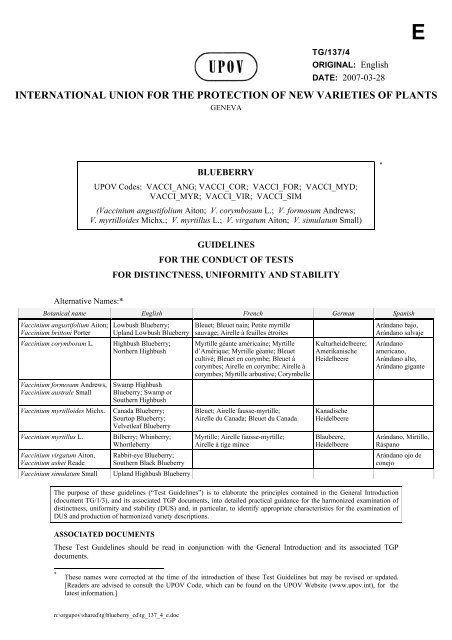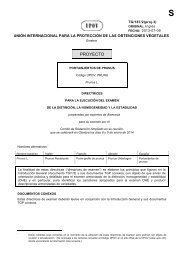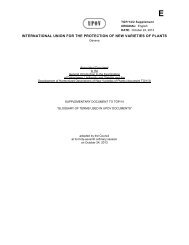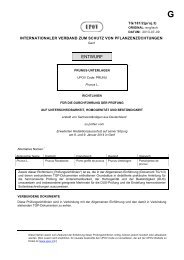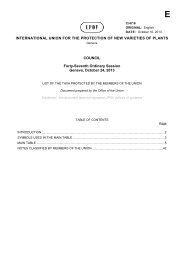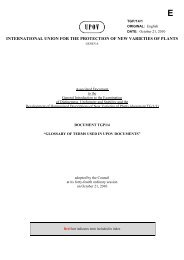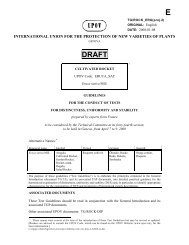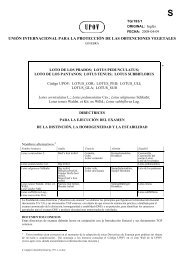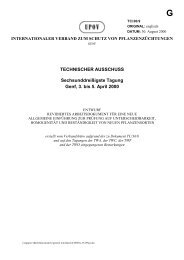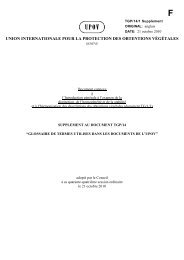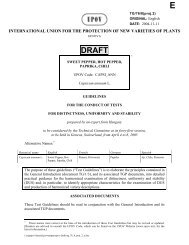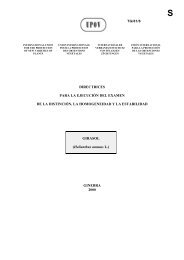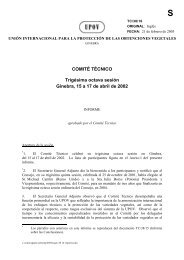E - International Union for the Protection of New Varieties of Plants
E - International Union for the Protection of New Varieties of Plants
E - International Union for the Protection of New Varieties of Plants
You also want an ePaper? Increase the reach of your titles
YUMPU automatically turns print PDFs into web optimized ePapers that Google loves.
n:\orgupov\shared\tg\blueberry_cd\tg_137_4_e.doc<br />
TG/137/4<br />
ORIGINAL: English<br />
DATE: 2007-03-28<br />
INTERNATIONAL UNION FOR THE PROTECTION OF NEW VARIETIES OF PLANTS<br />
GENEVA<br />
BLUEBERRY<br />
UPOV Codes: VACCI_ANG; VACCI_COR; VACCI_FOR; VACCI_MYD;<br />
VACCI_MYR; VACCI_VIR; VACCI_SIM<br />
(Vaccinium angustifolium Aiton; V. corymbosum L.; V. <strong>for</strong>mosum Andrews;<br />
V. myrtilloides Michx.; V. myrtillus L.; V. virgatum Aiton; V. simulatum Small)<br />
GUIDELINES<br />
FOR THE CONDUCT OF TESTS<br />
FOR DISTINCTNESS, UNIFORMITY AND STABILITY<br />
Alternative Names:*<br />
Botanical name English French German Spanish<br />
Vaccinium angustifolium Aiton;<br />
Vaccinium brittoni Porter<br />
Lowbush Blueberry;<br />
Upland Lowbush Blueberry<br />
Vaccinium corymbosum L. Highbush Blueberry;<br />
Nor<strong>the</strong>rn Highbush<br />
Vaccinium <strong>for</strong>mosum Andrews,<br />
Vaccinium australe Small<br />
Swamp Highbush<br />
Blueberry; Swamp or<br />
Sou<strong>the</strong>rn Highbush<br />
Vaccinium myrtilloides Michx. Canada Blueberry;<br />
Sourtop Blueberry;<br />
Velvetleaf Blueberry<br />
Vaccinium myrtillus L. Bilberry; Whinberry;<br />
Whortleberry<br />
Vaccinium virgatum Aiton,<br />
Vaccinium ashei Reade<br />
Rabbit-eye Blueberry;<br />
Sou<strong>the</strong>rn Black Blueberry<br />
Vaccinium simulatum Small Upland Highbush Blueberry<br />
Bleuet; Bleuet nain; Petite myrtille<br />
sauvage; Airelle à feuilles étroites<br />
Myrtille géante américaine; Myrtille<br />
d’Amérique; Myrtille géante; Bleuet<br />
cultivé; Bleuet en corymbe; Bleuet à<br />
corymbes; Airelle en corymbe; Airelle à<br />
corymbes; Myrtille arbustive; Corymbelle<br />
Bleuet; Airelle fausse-myrtille;<br />
Airelle du Canada; Bleuet du Canada<br />
Myrtille; Airelle fausse-myrtille;<br />
Airelle à tige mince<br />
Kulturheidelbeere;<br />
Amerikanische<br />
Heidelbeere<br />
Kanadische<br />
Heidelbeere<br />
Blaubeere,<br />
Heidelbeere<br />
*<br />
E<br />
Arándano bajo,<br />
Arándano salvaje<br />
Arándano<br />
americano,<br />
Arándano alto,<br />
Arándano gigante<br />
Arándano, Mirtillo,<br />
Ráspano<br />
Arándano ojo de<br />
conejo<br />
The purpose <strong>of</strong> <strong>the</strong>se guidelines (“Test Guidelines”) is to elaborate <strong>the</strong> principles contained in <strong>the</strong> General Introduction<br />
(document TG/1/3), and its associated TGP documents, into detailed practical guidance <strong>for</strong> <strong>the</strong> harmonized examination <strong>of</strong><br />
distinctness, uni<strong>for</strong>mity and stability (DUS) and, in particular, to identify appropriate characteristics <strong>for</strong> <strong>the</strong> examination <strong>of</strong><br />
DUS and production <strong>of</strong> harmonized variety descriptions.<br />
ASSOCIATED DOCUMENTS<br />
These Test Guidelines should be read in conjunction with <strong>the</strong> General Introduction and its associated TGP<br />
documents.<br />
* These names were corrected at <strong>the</strong> time <strong>of</strong> <strong>the</strong> introduction <strong>of</strong> <strong>the</strong>se Test Guidelines but may be revised or updated.<br />
[Readers are advised to consult <strong>the</strong> UPOV Code, which can be found on <strong>the</strong> UPOV Website (www.upov.int), <strong>for</strong> <strong>the</strong><br />
latest in<strong>for</strong>mation.]
TG/137/4<br />
Blueberry, 2007-03-28<br />
- 2 -<br />
TABLE OF CONTENTS PAGE<br />
1. SUBJECT OF THESE TEST GUIDELINES..................................................................................................3<br />
2. MATERIAL REQUIRED ...............................................................................................................................3<br />
3. METHOD OF EXAMINATION.....................................................................................................................3<br />
3.1 Number <strong>of</strong> Growing Cycles ....................................................................................................................3<br />
3.2 Testing Place...........................................................................................................................................3<br />
3.3 Conditions <strong>for</strong> Conducting <strong>the</strong> Examination...........................................................................................3<br />
3.4 Test Design .............................................................................................................................................4<br />
3.5 Number <strong>of</strong> <strong>Plants</strong> / Parts <strong>of</strong> <strong>Plants</strong> to be Examined.................................................................................4<br />
3.6 Additional Tests ......................................................................................................................................4<br />
4. ASSESSMENT OF DISTINCTNESS, UNIFORMITY AND STABILITY...................................................4<br />
4.1 Distinctness .............................................................................................................................................4<br />
4.2 Uni<strong>for</strong>mity...............................................................................................................................................5<br />
4.3 Stability ...................................................................................................................................................5<br />
5. GROUPING OF VARIETIES AND ORGANIZATION OF THE GROWING TRIAL.................................5<br />
6. INTRODUCTION TO THE TABLE OF CHARACTERISTICS...................................................................6<br />
6.1 Categories <strong>of</strong> Characteristics...................................................................................................................6<br />
6.2 States <strong>of</strong> Expression and Corresponding Notes.......................................................................................6<br />
6.3 Types <strong>of</strong> Expression................................................................................................................................6<br />
6.4 Example <strong>Varieties</strong> ...................................................................................................................................6<br />
6.5 Legend.....................................................................................................................................................6<br />
7. TABLE OF CHARACTERISTICS/TABLEAU DES<br />
CARACTÈRES/MERKMALSTABELLE/TABLA DE CARACTERES.......................................................7<br />
8. EXPLANATIONS ON THE TABLE OF CHARACTERISTICS ................................................................15<br />
8.1 Explanations covering several characteristics.......................................................................................15<br />
8.2 Explanations <strong>for</strong> individual characteristics ...........................................................................................15<br />
9. LITERATURE ..............................................................................................................................................17<br />
10. TECHNICAL QUESTIONNAIRE ...............................................................................................................18
1. Subject <strong>of</strong> <strong>the</strong>se Test Guidelines<br />
TG/137/4<br />
Blueberry, 2007-03-28<br />
- 3 -<br />
These Test Guidelines apply to all varieties <strong>of</strong> Vaccinium angustifolium Aiton<br />
(Vaccinium brittoni Porter); Vaccinium corymbosum L.; Vaccinium <strong>for</strong>mosum Andrews<br />
(Vaccinium australe Small); Vaccinium myrtilloides Michx.; Vaccinium myrtillus L.;<br />
Vaccinium virgatum Aiton (Vaccinium ashei Reade); and Vaccinium simulatum Small,<br />
including <strong>the</strong>ir hybrids, <strong>of</strong> <strong>the</strong> family Ericaceae.<br />
2. Material Required<br />
2.1 The competent authorities decide on <strong>the</strong> quantity and quality <strong>of</strong> <strong>the</strong> plant material<br />
required <strong>for</strong> testing <strong>the</strong> variety and when and where it is to be delivered. Applicants<br />
submitting material from a State o<strong>the</strong>r than that in which <strong>the</strong> testing takes place must ensure<br />
that all customs <strong>for</strong>malities and phytosanitary requirements are complied with.<br />
2.2 The material is to be supplied in <strong>the</strong> <strong>for</strong>m <strong>of</strong> plants with at least three well-developed<br />
shoots.<br />
2.3 The minimum quantity <strong>of</strong> plant material, to be supplied by <strong>the</strong> applicant, should be:<br />
5 plants with at least three well-developed shoots.<br />
2.4 The plant material supplied should be visibly healthy, not lacking in vigor, nor<br />
affected by any important pest or disease.<br />
2.5 The plant material should not have undergone any treatment which would affect <strong>the</strong><br />
expression <strong>of</strong> <strong>the</strong> characteristics <strong>of</strong> <strong>the</strong> variety, unless <strong>the</strong> competent authorities allow or<br />
request such treatment. If it has been treated, full details <strong>of</strong> <strong>the</strong> treatment must be given.<br />
3. Method <strong>of</strong> Examination<br />
3.1 Number <strong>of</strong> Growing Cycles<br />
3.1.1 The minimum duration <strong>of</strong> tests should normally be two independent growing cycles.<br />
3.1.2 The growing cycle is considered to be <strong>the</strong> duration <strong>of</strong> a single growing season,<br />
beginning with bud burst, flowering and fruit harvest and concluding when <strong>the</strong> following<br />
dormant period ends with <strong>the</strong> swelling <strong>of</strong> new season buds.<br />
3.2 Testing Place<br />
Tests are normally conducted at one place. In <strong>the</strong> case <strong>of</strong> tests conducted at more than<br />
one place, guidance is provided in TGP/9 “Examining Distinctness”.<br />
3.3 Conditions <strong>for</strong> Conducting <strong>the</strong> Examination<br />
3.3.1 The tests should be carried out under conditions ensuring satisfactory growth <strong>for</strong> <strong>the</strong><br />
expression <strong>of</strong> <strong>the</strong> relevant characteristics <strong>of</strong> <strong>the</strong> variety and <strong>for</strong> <strong>the</strong> conduct <strong>of</strong> <strong>the</strong><br />
examination. In particular, it is essential that <strong>the</strong> plants produce a satisfactory crop <strong>of</strong> fruit in<br />
each <strong>of</strong> <strong>the</strong> two growing cycles.
3.3.2 Type <strong>of</strong> observation<br />
TG/137/4<br />
Blueberry, 2007-03-28<br />
- 4 -<br />
The recommended method <strong>of</strong> observing <strong>the</strong> characteristic is indicated by <strong>the</strong><br />
following key in <strong>the</strong> second column <strong>of</strong> <strong>the</strong> Table <strong>of</strong> Characteristics:<br />
MG: single measurement <strong>of</strong> a group <strong>of</strong> plants or parts <strong>of</strong> plants<br />
MS: measurement <strong>of</strong> a number <strong>of</strong> individual plants or parts <strong>of</strong> plants<br />
VG: visual assessment by a single observation <strong>of</strong> a group <strong>of</strong> plants or parts <strong>of</strong> plants<br />
VS: visual assessment by observation <strong>of</strong> individual plants or parts <strong>of</strong> plants<br />
3.4 Test Design<br />
Each test should be designed to result in a total <strong>of</strong> at least 5 plants.<br />
3.5 Number <strong>of</strong> <strong>Plants</strong> / Parts <strong>of</strong> <strong>Plants</strong> to be Examined<br />
Unless o<strong>the</strong>rwise indicated, all observations should be made on 5 plants or parts taken<br />
from each <strong>of</strong> 5 plants. In <strong>the</strong> case <strong>of</strong> parts <strong>of</strong> plants, <strong>the</strong> number to be taken from each <strong>of</strong> <strong>the</strong><br />
plants should be 2.<br />
3.6 Additional Tests<br />
Additional tests, <strong>for</strong> examining relevant characteristics, may be established.<br />
4. Assessment <strong>of</strong> Distinctness, Uni<strong>for</strong>mity and Stability<br />
4.1 Distinctness<br />
4.1.1 General Recommendations<br />
It is <strong>of</strong> particular importance <strong>for</strong> users <strong>of</strong> <strong>the</strong>se Test Guidelines to consult <strong>the</strong> General<br />
Introduction prior to making decisions regarding distinctness. However, <strong>the</strong> following points<br />
are provided <strong>for</strong> elaboration or emphasis in <strong>the</strong>se Test Guidelines.<br />
4.1.2 Consistent Differences<br />
The differences observed between varieties may be so clear that more than one<br />
growing cycle is not necessary. In addition, in some circumstances, <strong>the</strong> influence <strong>of</strong> <strong>the</strong><br />
environment is not such that more than a single growing cycle is required to provide<br />
assurance that <strong>the</strong> differences observed between varieties are sufficiently consistent. One<br />
means <strong>of</strong> ensuring that a difference in a characteristic, observed in a growing trial, is<br />
sufficiently consistent is to examine <strong>the</strong> characteristic in at least two independent growing<br />
cycles.<br />
4.1.3 Clear Differences<br />
Determining whe<strong>the</strong>r a difference between two varieties is clear depends on many<br />
factors, and should consider, in particular, <strong>the</strong> type <strong>of</strong> expression <strong>of</strong> <strong>the</strong> characteristic being<br />
examined, i.e. whe<strong>the</strong>r it is expressed in a qualitative, quantitative, or pseudo-qualitative<br />
manner. There<strong>for</strong>e, it is important that users <strong>of</strong> <strong>the</strong>se Test Guidelines are familiar with <strong>the</strong>
TG/137/4<br />
Blueberry, 2007-03-28<br />
- 5 -<br />
recommendations contained in <strong>the</strong> General Introduction prior to making decisions regarding<br />
distinctness.<br />
4.2 Uni<strong>for</strong>mity<br />
4.2.1. It is <strong>of</strong> particular importance <strong>for</strong> users <strong>of</strong> <strong>the</strong>se Test Guidelines to consult <strong>the</strong> General<br />
Introduction prior to making decisions regarding uni<strong>for</strong>mity. However, <strong>the</strong> following points<br />
are provided <strong>for</strong> elaboration or emphasis in <strong>the</strong>se Test Guidelines:<br />
4.2.2. For <strong>the</strong> assessment <strong>of</strong> uni<strong>for</strong>mity, a population standard <strong>of</strong> 1% and an acceptance<br />
probability <strong>of</strong> at least 95% should be applied. In <strong>the</strong> case <strong>of</strong> a sample size <strong>of</strong> 5 plants, no<br />
<strong>of</strong>f-types are allowed.<br />
4.3 Stability<br />
4.3.1 In practice, it is not usual to per<strong>for</strong>m tests <strong>of</strong> stability that produce results as certain as<br />
those <strong>of</strong> <strong>the</strong> testing <strong>of</strong> distinctness and uni<strong>for</strong>mity. However, experience has demonstrated<br />
that, <strong>for</strong> many types <strong>of</strong> variety, when a variety has been shown to be uni<strong>for</strong>m, it can also be<br />
considered to be stable.<br />
4.3.2 Where appropriate, or in cases <strong>of</strong> doubt, stability may be tested, ei<strong>the</strong>r by growing a<br />
fur<strong>the</strong>r generation, or by testing a new plant stock to ensure that it exhibits <strong>the</strong> same<br />
characteristics as those shown by <strong>the</strong> previous material supplied.<br />
5. Grouping <strong>of</strong> <strong>Varieties</strong> and Organization <strong>of</strong> <strong>the</strong> Growing Trial<br />
5.1 The selection <strong>of</strong> varieties <strong>of</strong> common knowledge to be grown in <strong>the</strong> trial with <strong>the</strong><br />
candidate varieties and <strong>the</strong> way in which <strong>the</strong>se varieties are divided into groups to facilitate<br />
<strong>the</strong> assessment <strong>of</strong> distinctness are aided by <strong>the</strong> use <strong>of</strong> grouping characteristics.<br />
5.2 Grouping characteristics are those in which <strong>the</strong> documented states <strong>of</strong> expression, even<br />
where produced at different locations, can be used, ei<strong>the</strong>r individually or in combination with<br />
o<strong>the</strong>r such characteristics: (a) to select varieties <strong>of</strong> common knowledge that can be excluded<br />
from <strong>the</strong> growing trial used <strong>for</strong> examination <strong>of</strong> distinctness; and (b) to organize <strong>the</strong> growing<br />
trial so that similar varieties are grouped toge<strong>the</strong>r.<br />
5.3 The following have been agreed as useful grouping characteristics:<br />
(a) Plant: growth habit (characteristic 2)<br />
(b) Fruit: color <strong>of</strong> skin (after removal <strong>of</strong> bloom) (characteristic 27)<br />
(c) Plant: fruiting type (characteristic 31)<br />
(d) Time <strong>of</strong> beginning <strong>of</strong> flowering on one-year-old shoot (characteristic 33)<br />
(e) Only varieties which fruit on one-year-old and current season’s shoots: Time <strong>of</strong><br />
beginning <strong>of</strong> flowering on current year’s shoot (characteristic 34)<br />
(f) Time <strong>of</strong> beginning <strong>of</strong> fruit ripening on one-year-old shoot (characteristic 35)<br />
(g) Only varieties which fruit on one-year-old and current season’s shoots: Time <strong>of</strong><br />
beginning <strong>of</strong> fruit ripening on current year’s shoot (characteristic 36).
TG/137/4<br />
Blueberry, 2007-03-28<br />
- 6 -<br />
5.4 Guidance <strong>for</strong> <strong>the</strong> use <strong>of</strong> grouping characteristics, in <strong>the</strong> process <strong>of</strong> examining<br />
distinctness, is provided through <strong>the</strong> General Introduction.<br />
6. Introduction to <strong>the</strong> Table <strong>of</strong> Characteristics<br />
6.1 Categories <strong>of</strong> Characteristics<br />
6.1.1 Standard Test Guidelines Characteristics<br />
Standard Test Guidelines characteristics are those which are approved by UPOV <strong>for</strong><br />
examination <strong>of</strong> DUS and from which members <strong>of</strong> <strong>the</strong> <strong>Union</strong> can select those suitable <strong>for</strong> <strong>the</strong>ir<br />
particular circumstances.<br />
6.1.2 Asterisked Characteristics<br />
Asterisked characteristics (denoted by *) are those included in <strong>the</strong> Test Guidelines<br />
which are important <strong>for</strong> <strong>the</strong> international harmonization <strong>of</strong> variety descriptions and should<br />
always be examined <strong>for</strong> DUS and included in <strong>the</strong> variety description by all members <strong>of</strong> <strong>the</strong><br />
<strong>Union</strong>, except when <strong>the</strong> state <strong>of</strong> expression <strong>of</strong> a preceding characteristic or regional<br />
environmental conditions render this inappropriate.<br />
6.2 States <strong>of</strong> Expression and Corresponding Notes<br />
States <strong>of</strong> expression are given <strong>for</strong> each characteristic to define <strong>the</strong> characteristic and to<br />
harmonize descriptions. Each state <strong>of</strong> expression is allocated a corresponding numerical note<br />
<strong>for</strong> ease <strong>of</strong> recording <strong>of</strong> data and <strong>for</strong> <strong>the</strong> production and exchange <strong>of</strong> <strong>the</strong> description.<br />
6.3 Types <strong>of</strong> Expression<br />
An explanation <strong>of</strong> <strong>the</strong> types <strong>of</strong> expression <strong>of</strong> characteristics (qualitative, quantitative<br />
and pseudo-qualitative) is provided in <strong>the</strong> General Introduction.<br />
6.4 Example <strong>Varieties</strong><br />
Where appropriate, example varieties are provided to clarify <strong>the</strong> states <strong>of</strong> expression<br />
<strong>of</strong> each characteristic.<br />
6.5 Legend<br />
(*) Asterisked characteristic – see Chapter 6.1.2<br />
QL: Qualitative characteristic – see Chapter 6.3<br />
QN: Quantitative characteristic – see Chapter 6.3<br />
PQ: Pseudo-qualitative characteristic – see Chapter 6.3<br />
MG, MS, VG, VS: see Chapter 3.3.2<br />
(a)-(d) See Explanations on <strong>the</strong> Table <strong>of</strong> Characteristics in Chapter 8.1<br />
(+) See Explanations on <strong>the</strong> Table <strong>of</strong> Characteristics in Chapter 8.2
1.<br />
(*)<br />
(+)<br />
TG/137/4<br />
Blueberry/Myrtille/Heidelbeere/Arándano, 2007-03-28<br />
- 7 -<br />
7. Table <strong>of</strong> Characteristics/Tableau des caractères/Merkmalstabelle/Tabla de caracteres<br />
English français Deutsch español<br />
VG Plant: vigor Plante: vigueur Pflanze: Wuchsstärke Planta: vigor<br />
Example <strong>Varieties</strong>/<br />
Exemples/<br />
Beispielssorten/<br />
Variedades ejemplo<br />
QN (a) weak faible schwach débil Bluetta, Weymouth 3<br />
2.<br />
(*)<br />
medium moyenne mittel medio Patriot, Bluejay 5<br />
strong <strong>for</strong>te stark fuerte Bluecrop, Duke,<br />
Earliblue<br />
VG Plant: growth habit Plante: port Pflanze: Wuchs<strong>for</strong>m Planta: porte<br />
PQ (a) upright dressé aufrecht erecto Ivanhoe 1<br />
semi upright demi dressé halbaufrecht semierecto Bluetta 2<br />
spreading étalé breitwüchsig rastrero Jersey 3<br />
3. VG One-year-old shoot:<br />
color<br />
Rameau d’un an:<br />
couleur<br />
Einjähriger Trieb:<br />
Farbe<br />
Rama de un año:<br />
color<br />
PQ (a) green verte grün verde Puru 1<br />
greenish red rouge verdâtre grünlichrot rojo verdoso Reka 2<br />
greyish red rouge grisâtre gräulichrot rojo grisáceo Berkeley 3<br />
reddish yellow jaune rougeâtre rötlichgelb amarillo rojizo Heerma 4<br />
reddish brown brun rougeâtre rötlichbraun marrón rojizo Earliblue 5<br />
dark red rouge foncé dunkelrot rojo oscuro Aron 6<br />
4. VG One-year-old shoot:<br />
length <strong>of</strong> internode<br />
(upper half)<br />
Rameau d’un an:<br />
longueur de l’entrenœud<br />
(moitié<br />
supérieure)<br />
Einjähriger Trieb:<br />
Länge des Internodiums<br />
(obere<br />
Hälfte)<br />
Rama de un año:<br />
longitud del entrenudo<br />
(mitad<br />
superior)<br />
QN (a) short court kurz corta 3<br />
medium moyen mittel media 5<br />
long long lang larga 7<br />
Note/<br />
Nota<br />
7
5.<br />
(*)<br />
MS/<br />
VG<br />
TG/137/4<br />
Blueberry/Myrtille/Heidelbeere/Arándano, 2007-03-28<br />
- 8 -<br />
English français Deutsch español<br />
Leaf: length Feuille: longueur Blatt: Länge Hoja: longitud<br />
Example <strong>Varieties</strong>/<br />
Exemples/<br />
Beispielssorten/<br />
Variedades ejemplo<br />
QN (b) short courte kurz corta Darrow 3<br />
6. MS/<br />
VG<br />
medium moyenne mittel media Bluecrop, Patriot 5<br />
long longue lang larga Collins, Berkeley,<br />
Toro<br />
Leaf: width Feuille: largeur Blatt: Breite Hoja: anchura<br />
QN (b) narrow étroite schmal estrecha Emil, Heerma, Putte 3<br />
7. MS/<br />
VG<br />
medium moyenne mittel media Ama, Bluecrop 5<br />
broad large breit ancha Collins, Berkeley 7<br />
Leaf: ratio<br />
length/width<br />
Feuille: rapport<br />
longueur/largeur<br />
Blatt: Verhältnis<br />
Länge/Breite<br />
Hoja: relación<br />
longitud/anchura<br />
QN (b) small petit klein pequeña Gretha 3<br />
8.<br />
(*)<br />
medium moyen mittel media Patriot 5<br />
large grand groß grande Heerma 7<br />
VG Leaf: shape Feuille: <strong>for</strong>me Blatt: Form Hoja: <strong>for</strong>ma<br />
PQ (b) lanceolate lancéolée lanzettlich lanceolada Weymouth 1<br />
ovate ovale eiförmig oval Puru 2<br />
elliptic elliptique elliptisch elíptica Rancocas, Earliblue 3<br />
oblong oblongue rechteckig oblonga Berkeley, Bluetta,<br />
Jersey<br />
9. VG Leaf: color <strong>of</strong> upper<br />
side<br />
Feuille: couleur de la<br />
face supérieure<br />
Blatt: Farbe der<br />
Oberseite<br />
Hoja: color del haz<br />
QL (b) yellow jaune gelb amarillo Geerdens 1<br />
green verte grün verde 2<br />
Note/<br />
Nota<br />
7<br />
4
10.<br />
(*)<br />
TG/137/4<br />
Blueberry/Myrtille/Heidelbeere/Arándano, 2007-03-28<br />
- 9 -<br />
English français Deutsch español<br />
VG Only varieties with<br />
green leaf color:<br />
Leaf: intensity <strong>of</strong><br />
green color on upper<br />
side<br />
Seulement variétés à<br />
feuilles de couleur<br />
verte: Feuille: intensité<br />
de la couleur<br />
verte sur la face<br />
supérieure<br />
Nur Sorten mit<br />
grüner Blattfarbe:<br />
Blatt: Intensität der<br />
Grünfärbung an der<br />
Oberseite<br />
Sólo variedades con<br />
hoja de color verde:<br />
Hoja: intensidad del<br />
color verde del haz<br />
Example <strong>Varieties</strong>/<br />
Exemples/<br />
Beispielssorten/<br />
Variedades ejemplo<br />
QN (b) light claire hell clara Earliblue 3<br />
11.<br />
(*)<br />
medium moyenne mittel media Berkeley, Toro 5<br />
dark foncée dunkel oscura Weymouth, Darrow 7<br />
VG Leaf: margin Feuille: bord Blatt: Rand Hoja: margen<br />
QL (b) entire entier ganzrandig entero Blueray, Jersey 1<br />
serrate denté gesägt serrado Brigitta, Rancocas 2<br />
12. VG Flower bud: anthocyanin<br />
coloration<br />
Bourgeon: pigmentation<br />
anthocyanique<br />
Blütenknospe:<br />
Anthocyanfärbung<br />
Botón floral: pigmentación<br />
antociánica<br />
QN (a) weak faible gering débil Hele 3<br />
13. MS/<br />
VG<br />
medium moyenne mittel media Patriot 5<br />
strong <strong>for</strong>te stark fuerte Bluecrop 7<br />
Inflorescence: length<br />
(excluding peduncle)<br />
Inflorescence: Blütenstand: Länge<br />
longueur (à l’ex- (ohne<br />
clusion du pédoncule) Blütenstandsstiel)<br />
Inflorescencia:<br />
longitud (excluido el<br />
pedúnculo)<br />
QN (c) short courte kurz corta Bluetta, Collins 3<br />
medium moyenne mittel media Duke, Earliblue 5<br />
long longue lang larga Berkeley, Bluecrop 7<br />
14. VG Flower: shape <strong>of</strong><br />
corolla<br />
Fleur: <strong>for</strong>me de la<br />
corolle<br />
Blüte: Form der<br />
Krone<br />
Flor: <strong>for</strong>ma de la<br />
corola<br />
PQ (c) urceolate urcéolée urnenförmig urceolada Maru 1<br />
campanulate campanulée glockenförmig acampanada 2<br />
cylindrical cylindrique zylindrisch cilíndrica Reka 3<br />
Note/<br />
Nota
15.<br />
(*)<br />
TG/137/4<br />
Blueberry/Myrtille/Heidelbeere/Arándano, 2007-03-28<br />
- 10 -<br />
English français Deutsch español<br />
VG Flower: size <strong>of</strong><br />
corolla tube<br />
Fleur: taille du tube<br />
de la corolle<br />
Blüte: Größe der<br />
Kronenröhre<br />
Flor: tamaño del<br />
tubo de la corola<br />
Example <strong>Varieties</strong>/<br />
Exemples/<br />
Beispielssorten/<br />
Variedades ejemplo<br />
QN (c) small petit klein pequeño Blueray 3<br />
16.<br />
(*)<br />
medium moyen mittel medio Heerma 5<br />
large grand groß grande Collins 7<br />
VG Flower: anthocyanin<br />
coloration <strong>of</strong> corolla<br />
tube<br />
Fleur: pigmentation<br />
anthocyanique du<br />
tube de la corolle<br />
Blüte: Anthocyanfärbung<br />
der<br />
Kronenröhre<br />
QN (c) absent or very weak nulle ou très faible fehlend oder sehr<br />
gering<br />
Flor: pigmentación<br />
antociánica del tubo<br />
de la corola<br />
Note/<br />
Nota<br />
ausente o muy débil Maru 1<br />
weak faible gering débil Ama 3<br />
medium moyenne mittel media Gretha 5<br />
strong <strong>for</strong>te stark fuerte Bluecrop 7<br />
17. VG Flower: ridges on<br />
corolla tube<br />
Fleur: cannelures sur<br />
le tube de la corolle<br />
Blüte: Rippen an der<br />
Kronenröhre<br />
Flor: aristas en el<br />
tubo de la corola<br />
QL (c) absent absentes fehlend ausentes 1<br />
present présentes vorhanden presentes 9<br />
18. VG Fruit cluster: density Bouquet de fruit:<br />
densité<br />
Fruchtgruppe: Dichte Racimos de fruto:<br />
densidad<br />
QN (d) sparse lâche locker baja Rahi 3<br />
19.<br />
(*)<br />
medium moyenne mittel media Toro 5<br />
dense dense dicht alta Tifblue 7<br />
VG Unripe fruit:<br />
intensity <strong>of</strong> green<br />
color<br />
Fruit non mûr:<br />
intensité de la<br />
couleur verte<br />
Unreife Frucht:<br />
Intensität der<br />
Grünfärbung<br />
Fruto no maduro:<br />
intensidad del color<br />
verde<br />
QN light claire hell clara Heerma 3<br />
medium moyenne mittel media Ama 5<br />
dark foncée dunkel oscura Berkeley 7
20.<br />
(*)<br />
TG/137/4<br />
Blueberry/Myrtille/Heidelbeere/Arándano, 2007-03-28<br />
- 11 -<br />
English français Deutsch español<br />
VG Fruit: size Fruit: taille Frucht: Größe Fruto: tamaño<br />
Example <strong>Varieties</strong>/<br />
Exemples/<br />
Beispielssorten/<br />
Variedades ejemplo<br />
QN (d) small petit klein pequeño Ama 3<br />
21.<br />
(*)<br />
(+)<br />
medium moyen mittel medio Concord 5<br />
large gros groß grande Darrow 7<br />
VG Fruit: shape in<br />
longitudinal section<br />
Fruit: <strong>for</strong>me en<br />
section longitudinale<br />
Frucht: Form im<br />
Längsschnitt<br />
Fruto: <strong>for</strong>ma en<br />
sección longitudinal<br />
PQ (d) elliptic elliptique elliptisch elíptica Northland 1<br />
round arrondi rund redonda Bluecrop, Jersey 2<br />
oblate aplati breitrund oblata Earliblue 3<br />
22. VG Fruit: attitude <strong>of</strong><br />
sepals<br />
Fruit: port des<br />
sépales<br />
Frucht: Haltung der<br />
Kelchblätter<br />
Fruto: porte de los<br />
sépalos<br />
QN (d) erect dressé aufrecht erecto Powderblue 1<br />
erect to semi-erect dressé à demi-dressé aufrecht bis<br />
halbaufrecht<br />
entre erecto y<br />
semierecto<br />
semi-erect demi-dressé halbaufrecht semierecto Tifblue 3<br />
23. VG Fruit: type <strong>of</strong> sepals Fruit: type de sépales Frucht: Typ der<br />
Kelchblätter<br />
Fruto: tipo de sépalos<br />
QN (d) incurving incurvé aufgebogen incurvado Delite 1<br />
straight droit gerade recto Powderblue 2<br />
reflexed récurvé zurückgebogen recurvado Tifblue 3<br />
24. VG Fruit: diameter <strong>of</strong><br />
calyx basin<br />
Fruit: diamètre de la<br />
cuvette du calice<br />
Frucht: Durchmesser<br />
der Kelchhöhle<br />
Fruto: diámetro de la<br />
cavidad del cáliz<br />
QN (d) small petit klein pequeño Blueray 3<br />
medium moyen mittel medio Bluecrop 5<br />
large grand groß grande Darrow 7<br />
Note/<br />
Nota<br />
2
TG/137/4<br />
Blueberry/Myrtille/Heidelbeere/Arándano, 2007-03-28<br />
- 12 -<br />
English français Deutsch español<br />
25. VG Fruit: depth <strong>of</strong> calyx<br />
basin<br />
Fruit: pr<strong>of</strong>ondeur de<br />
la cuvette du calice<br />
Frucht: Tiefe der<br />
Kelchhöhle<br />
Fruto: pr<strong>of</strong>undidad<br />
de la cavidad del cáliz<br />
Example <strong>Varieties</strong>/<br />
Exemples/<br />
Beispielssorten/<br />
Variedades ejemplo<br />
QN (d) shallow peu pr<strong>of</strong>onde flach poco pr<strong>of</strong>unda Collins 3<br />
26.<br />
(*)<br />
medium moyenne mittel media Blueray 5<br />
deep pr<strong>of</strong>onde tief pr<strong>of</strong>unda Heidi, Jersey 7<br />
VG Fruit: intensity <strong>of</strong><br />
bloom<br />
Fruit: intensité de la<br />
pruine<br />
Frucht: Intensität der<br />
Bereifung<br />
Fruto: intensidad de<br />
la pruina<br />
QN (d) very weak très faible sehr gering muy débil Goldtraube 1<br />
27.<br />
(*)<br />
weak faible gering débil Gretha 3<br />
medium moyenne mittel media Ama, Bluetta 5<br />
strong <strong>for</strong>te stark fuerte Darrow, Gila 7<br />
VG Fruit: color <strong>of</strong> skin<br />
(after removal <strong>of</strong><br />
bloom)<br />
Fruit: couleur de<br />
l’épiderme (après<br />
retrait de la pruine)<br />
Frucht: Farbe der<br />
Schale (nach Entfernung<br />
der Bereifung)<br />
Fruto: color de la<br />
epidermis (tras<br />
quitar la pruina)<br />
PQ (d) light blue bleu clair hellblau azul claro Berkeley 1<br />
28.<br />
(+)<br />
VG/<br />
MG<br />
medium blue bleu moyen mittelblau azul medio Patriot 2<br />
dark blue bleu foncé dunkelblau azul oscuro Heerma 3<br />
blue red bleu rouge blaurot rojo azulado Delite 4<br />
Fruit: firmness Fruit: fermeté Frucht: Festigkeit Fruto: firmeza<br />
QN (d) s<strong>of</strong>t mou weich blando 3<br />
29.<br />
(*)<br />
(+)<br />
medium intermédiaire mittel medio O’Neil 5<br />
firm ferme fest firme Duke 7<br />
very firm très ferme sehr fest muy firme Rahi 9<br />
VG Fruit: sweetness Fruit: goût sucré Frucht: Süße Fruto: dulzor<br />
QN (d) low faible gering bajo Bluetta 3<br />
medium moyen mittel medio Collins 5<br />
high <strong>for</strong>t stark alto Goldtraube 7<br />
Note/<br />
Nota
30.<br />
(*)<br />
(+)<br />
TG/137/4<br />
Blueberry/Myrtille/Heidelbeere/Arándano, 2007-03-28<br />
- 13 -<br />
English français Deutsch español<br />
VG Fruit: acidity Fruit: acidité Frucht: Säure Fruto: acidez<br />
Example <strong>Varieties</strong>/<br />
Exemples/<br />
Beispielssorten/<br />
Variedades ejemplo<br />
QN (d) low faible gering baja Gretha 3<br />
31.<br />
(*)<br />
medium moyenne mittel media Darrow 5<br />
high <strong>for</strong>te stark alta Ascorba, Bluecrop 7<br />
VG Plant: fruiting type Plante: type de<br />
fructification<br />
QL (c) on one-year-old shoots<br />
only<br />
32.<br />
(*)<br />
(+)<br />
seulement sur des<br />
rameaux d’un an<br />
on one-year-old and sur des rameaux d’un<br />
current season’s shoots an et des rameaux en<br />
croissance<br />
MG Time <strong>of</strong> vegetative<br />
bud burst<br />
Époque de<br />
débourrement<br />
Pflanze:<br />
Fruchtungstyp<br />
nur an einjährigen<br />
Trieben<br />
an einjährigen Trieben<br />
und an Jahrestrieben<br />
Zeitpunkt des<br />
Aufbruchs der<br />
vegetativen Knospe<br />
Planta: tipo de<br />
fructificación<br />
sólo en ramas de un<br />
año<br />
Note/<br />
Nota<br />
Darrow, Patriot 1<br />
en ramas de un año y<br />
en ramas de la estación<br />
Concord, Burlington 2<br />
Época de aparición<br />
de la yema de madera<br />
QN early précoce früh temprana Patriot,Weymouth 3<br />
33.<br />
(*)<br />
(+)<br />
medium moyenne mittel media Bluecrop 5<br />
late tardive spät tardía Blueray 7<br />
MG Time <strong>of</strong> beginning <strong>of</strong><br />
flowering on<br />
one-year-old shoot<br />
Époque du début de<br />
la floraison sur les<br />
rameaux d’un an<br />
Zeitpunkt des<br />
Blühbeginns am<br />
einjährigen Trieb<br />
Época de inicio de la<br />
floración en la rama<br />
de un año<br />
QN very early très précoce sehr früh muy temprana Patriot 1<br />
early précoce früh temprana Weymouth 3<br />
medium moyenne mittel media Berkeley 5<br />
late tardive spät tardía Darrow 7<br />
very late très tardive sehr spät muy tardía Jersey 9
34.<br />
(*)<br />
(+)<br />
TG/137/4<br />
Blueberry/Myrtille/Heidelbeere/Arándano, 2007-03-28<br />
- 14 -<br />
English français Deutsch español<br />
MG Only varieties which<br />
fruit on one-year-old<br />
and current season’s<br />
shoots: Time <strong>of</strong><br />
beginning <strong>of</strong><br />
flowering on current<br />
year’s shoot<br />
Seulement variétés<br />
avec fruit sur les<br />
rameaux d’un an et<br />
les rameaux en<br />
croissance : Époque<br />
du début de la<br />
floraison sur les<br />
rameaux en<br />
croissance<br />
Nur Sorten, die am<br />
einjährigen Trieb<br />
und am Jahrestrieb<br />
Früchte tragen: Zeitpunkt<br />
des Blühbeginns<br />
am<br />
Jahrestrieb<br />
Sólo variedades que<br />
fructifican en ramas<br />
de un año y en ramas<br />
de la estación: Época<br />
de inicio de la<br />
floración en la rama<br />
del corriente año<br />
Example <strong>Varieties</strong>/<br />
Exemples/<br />
Beispielssorten/<br />
Variedades ejemplo<br />
QN early précoce früh temprana O’Neal 3<br />
35.<br />
(*)<br />
(+)<br />
medium moyenne mittel media JU83 5<br />
late tardive spät tardía 7<br />
MG Time <strong>of</strong> beginning <strong>of</strong><br />
fruit ripening on<br />
one-year-old shoot<br />
Époque du début de Zeitpunkt des Be-<br />
la maturation des ginns der Fruchtreife<br />
fruits sur les rameaux am einjährigen Trieb<br />
d’un an<br />
Época de inicio de la<br />
madurez del fruto en<br />
la rama de un año<br />
QN very early très précoce sehr früh muy temprana Bluetta 1<br />
36.<br />
(*)<br />
(+)<br />
MG/<br />
QN<br />
early précoce früh temprana Blueray 3<br />
medium moyenne mittel media Heerma 5<br />
late tardive spät tardía Darrow 7<br />
very late très tardive sehr spät muy tardía Elizabeth 9<br />
Only varieties which<br />
fruit on one-year-old<br />
and current season’s<br />
shoots: Time <strong>of</strong><br />
beginning <strong>of</strong> fruit<br />
ripening on current<br />
year’s shoot<br />
Seulement variétés<br />
avec fruit sur les<br />
rameaux d’un an et<br />
les rameaux en<br />
croissance: Époque<br />
du début de la<br />
maturation des fruits<br />
sur les rameaux en<br />
croissance<br />
Nur Sorten, die am<br />
einjährigen Trieb<br />
und am Jahrestrieb<br />
Früchte tragen: Zeitpunkt<br />
des Beginns<br />
der Fruchtreife am<br />
Jahrestrieb<br />
Sólo variedades que<br />
fructifican en ramas<br />
de un año y en ramas<br />
de la estación: Época<br />
de inicio de la<br />
madurez del fruto en<br />
la rama del corriente<br />
año<br />
QN early précoce früh temprana O’Neal 3<br />
medium moyenne mittel media JU83 5<br />
late tardive spät tardía 7<br />
Note/<br />
Nota
TG/137/4<br />
Blueberry, 2007-03-28<br />
- 15 -<br />
8. Explanations on <strong>the</strong> Table <strong>of</strong> Characteristics<br />
8.1 Explanations covering several characteristics<br />
Characteristics containing <strong>the</strong> following key in <strong>the</strong> second column <strong>of</strong> <strong>the</strong> Table <strong>of</strong><br />
Characteristics should be examined as indicated below:<br />
(a) Observations on <strong>the</strong> plant should be made on unpruned bushes in <strong>the</strong> dormant<br />
season.<br />
(b) Observations on <strong>the</strong> leaf should be made on fully developed leaves in early<br />
summer.<br />
(c) Observations on <strong>the</strong> inflorescence and flower should be made at <strong>the</strong> time <strong>of</strong><br />
full flowering.<br />
(d) Unless o<strong>the</strong>rwise stated, observations on <strong>the</strong> fruit should be made on<br />
physiologically ripe fruits.<br />
8.2 Explanations <strong>for</strong> individual characteristics<br />
Ad. 1: Plant: vigor<br />
The plant vigor should be considered as <strong>the</strong> overall abundance <strong>of</strong> vegetative growth.<br />
Ad. 21: Fruit: shape in longitudinal section<br />
Ad. 28: Fruit: firmness<br />
1 2 3<br />
elliptic round oblate<br />
Firmness should be determined by hand in comparison to <strong>the</strong> example varieties, or<br />
measured using a penetrometer.<br />
Ad. 29: Fruit: sweetness<br />
Ad. 30: Fruit: acidity<br />
Sweetness and acidity should be observed by tasting in comparison to <strong>the</strong> example<br />
varieties.
Ad. 32: Time <strong>of</strong> vegetative bud burst<br />
TG/137/4<br />
Blueberry, 2007-03-28<br />
- 16 -<br />
The time <strong>of</strong> vegetative bud burst is when <strong>the</strong> first vegetative buds begin to burst.<br />
Ad. 33: Time <strong>of</strong> beginning <strong>of</strong> flowering on one-year old shoot<br />
Ad. 34: Only varieties which fruit on one-year-old and current season’s shoots: Time <strong>of</strong><br />
beginning <strong>of</strong> flowering on current year’s shoot<br />
The time <strong>of</strong> beginning <strong>of</strong> flowering is when 10% <strong>of</strong> <strong>the</strong> flowers are fully open.<br />
Ad. 35: Time <strong>of</strong> beginning <strong>of</strong> fruit ripening on one-year-old shoot<br />
Ad. 36: Only varieties which fruit on one-year-old and current season’s shoots: Time <strong>of</strong><br />
beginning <strong>of</strong> fruit ripening on current year’s shoot<br />
The time <strong>of</strong> beginning <strong>of</strong> fruit ripening is when 10% <strong>of</strong> <strong>the</strong> fruits are ripe.
9. Literature<br />
TG/137/4<br />
Blueberry, 2007-03-28<br />
- 17 -<br />
Ebert, G., 2005: Anbau von Heidelbeeren und Cranberries. Ulmer Verlag, Stuttgart, DE.<br />
Liebster, G., 1961: Die Kulturheidelbeere. Parey Verlag, Berlin und Hamburg, DE.<br />
Rejman, A., 1994: Pomologia. PWRiL, Warszawa, PL.<br />
Rejman, A., Pliszka, K., 1988: Borówka wysoka. PWRiL, Warszawa, PL.<br />
Sękowski, B., 1993: Pomologia systematyczna. PWN, Warszawa, PL.<br />
Sorge, P., 1984: Beerenobstsorten. J. Neumann-Neudamm, Melsungen, DE.
10. Technical Questionnaire<br />
TECHNICAL QUESTIONNAIRE<br />
TG/137/4<br />
Blueberry, 2007-03-28<br />
- 18 -<br />
Page {x} <strong>of</strong> {y}<br />
TECHNICAL QUESTIONNAIRE<br />
Reference Number:<br />
Application date:<br />
(not to be filled in by <strong>the</strong> applicant)<br />
to be completed in connection with an application <strong>for</strong> plant breeders’ rights<br />
1. Subject <strong>of</strong> <strong>the</strong> Technical Questionnaire<br />
1.1.1 Botanical name Vaccinium angustifolium Aiton, Vaccinium brittoni Porter [ ]<br />
1.1.2 Common name Lowbush Blueberry, Upland Lowbush Blueberry<br />
1.2.1 Botanical name Vaccinium corymbosum L. [ ]<br />
1.2.2 Common name Highbush Blueberry; Nor<strong>the</strong>rn Highbush<br />
1.3.1 Botanical name Vaccinium <strong>for</strong>mosum Andrews, Vaccinium australe Small [ ]<br />
1.3.2 Common name Swamp Highbush Blueberry; Swamp or Sou<strong>the</strong>rn Highbush<br />
1.4.1 Botanical name Vaccinium myrtilloides Michx. [ ]<br />
1.4.2 Common name Canada Blueberry, Sourtop Blueberry, Velvetleaf Blueberry<br />
1.5.1 Botanical name Vaccinium myrtillus L. [ ]<br />
1.5.2 Common name Bilberry, Whinberry, Whortleberry<br />
1.6.1 Botanical name Vaccinium virgatum Aiton, Vaccinium ashei Reade [ ]<br />
1.6.2 Common name Rabbit-eye Blueberry, Sou<strong>the</strong>rn Black Blueberry<br />
1.7.1 Botanical name Vaccinium simulatum Small [ ]<br />
1.7.2 Common name Upland Highbush Blueberry<br />
1.8 Hybrid: please indicate name(s) <strong>of</strong> species used in <strong>the</strong> crossing<br />
Botanical name [ ]
TECHNICAL QUESTIONNAIRE<br />
2. Applicant<br />
Name<br />
Address<br />
Telephone No.<br />
Fax No.<br />
E-mail address<br />
Breeder (if different from applicant)<br />
TG/137/4<br />
Blueberry, 2007-03-28<br />
- 19 -<br />
Page {x} <strong>of</strong> {y}<br />
3. Proposed denomination and breeder’s reference<br />
Proposed denomination<br />
(if available)<br />
Breeder’s reference<br />
Reference Number:
TECHNICAL QUESTIONNAIRE<br />
TG/137/4<br />
Blueberry, 2007-03-28<br />
- 20 -<br />
Page {x} <strong>of</strong> {y}<br />
Reference Number:<br />
# 4. In<strong>for</strong>mation on <strong>the</strong> breeding scheme and propagation <strong>of</strong> <strong>the</strong> variety<br />
4.1 Breeding scheme<br />
Variety resulting from:<br />
4.1.1 Crossing<br />
(a) controlled cross [ ]<br />
(please state parent varieties)<br />
(b) partially known cross [ ]<br />
(please state known parent variety(ies))<br />
(c) unknown cross [ ]<br />
4.1.2 Mutation [ ]<br />
(please state parent variety)<br />
4.1.3 Discovery and development [ ]<br />
(please state where and when discovered<br />
and how developed)<br />
4.1.4 O<strong>the</strong>r [ ]<br />
(please provide details)<br />
4.2 Method <strong>of</strong> propagating <strong>the</strong> variety<br />
4.2.1 Vegetative propagation<br />
(a) cuttings [ ]<br />
(b) in vitro propagation [ ]<br />
(c) o<strong>the</strong>r (state method) [ ]<br />
4.2.2. O<strong>the</strong>r [ ]<br />
(please provide details)<br />
# Authorities may allow certain <strong>of</strong> this in<strong>for</strong>mation to be provided in a confidential section <strong>of</strong> <strong>the</strong> Technical Questionnaire.
TECHNICAL QUESTIONNAIRE<br />
TG/137/4<br />
Blueberry, 2007-03-28<br />
- 21 -<br />
Page {x} <strong>of</strong> {y}<br />
Reference Number:<br />
5. Characteristics <strong>of</strong> <strong>the</strong> variety to be indicated (<strong>the</strong> number in brackets refers to <strong>the</strong> corresponding<br />
characteristic in Test Guidelines; please mark <strong>the</strong> note which best corresponds)<br />
5.1<br />
(2)<br />
5.2<br />
(27)<br />
5.3<br />
(31)<br />
5.4<br />
(33)<br />
5.5<br />
(34)<br />
Characteristics Example <strong>Varieties</strong> Note<br />
Plant: growth habit<br />
upright Ivanhoe 1[ ]<br />
semi upright Bluetta 2[ ]<br />
spreading Jersey 3[ ]<br />
Fruit: color <strong>of</strong> skin (after removal <strong>of</strong> bloom)<br />
light blue Berkeley 1[ ]<br />
medium blue Patriot 2[ ]<br />
dark blue Heerma 3[ ]<br />
blue red Delite 4[ ]<br />
Plant: fruiting type<br />
on one-year-old shoots only Darrow, Patriot 1[ ]<br />
on one-year-old and current season’s shoots Concord, Burlington 2[ ]<br />
Time <strong>of</strong> beginning <strong>of</strong> flowering on one-year-old shoot<br />
very early Patriot 1[ ]<br />
early Weymouth 3[ ]<br />
medium Berkeley 5[ ]<br />
late Darrow 7[ ]<br />
very late Jersey 9[ ]<br />
Only varieties which fruit on one-year-old and current season’s<br />
shoots: Time <strong>of</strong> beginning <strong>of</strong> flowering on current year’s shoot<br />
early O’Neal 3[ ]<br />
medium JU83 5[ ]<br />
late 7[ ]
TECHNICAL QUESTIONNAIRE<br />
5.6<br />
(35)<br />
5.7<br />
(36)<br />
TG/137/4<br />
Blueberry, 2007-03-28<br />
- 22 -<br />
Page {x} <strong>of</strong> {y}<br />
Reference Number:<br />
Characteristics Example <strong>Varieties</strong> Note<br />
Time <strong>of</strong> beginning <strong>of</strong> fruit ripening on one-year-old shoot<br />
very early Bluetta 1[ ]<br />
early Blueray 3[ ]<br />
medium Heerma 5[ ]<br />
late Darrow 7[ ]<br />
very late Elizabeth 9[ ]<br />
Only varieties which fruit on one-year-old and current season’s<br />
shoots: Time <strong>of</strong> beginning <strong>of</strong> fruit ripening on current year’s shoot<br />
early O’Neal 3[ ]<br />
medium JU83 5[ ]<br />
late 7[ ]
TECHNICAL QUESTIONNAIRE<br />
TG/137/4<br />
Blueberry, 2007-03-28<br />
- 23 -<br />
Page {x} <strong>of</strong> {y}<br />
6. Similar varieties and differences from <strong>the</strong>se varieties<br />
Reference Number:<br />
Please use <strong>the</strong> following table and box <strong>for</strong> comments to provide in<strong>for</strong>mation on how your<br />
candidate variety differs from <strong>the</strong> variety (or varieties) which, to <strong>the</strong> best <strong>of</strong> your knowledge, is (or<br />
are) most similar. This in<strong>for</strong>mation may help <strong>the</strong> examination authority to conduct its examination<br />
<strong>of</strong> distinctness in a more efficient way.<br />
Denomination(s) <strong>of</strong><br />
variety(ies) similar to<br />
your candidate variety<br />
Comments:<br />
Characteristic(s) in<br />
which your candidate<br />
variety differs from <strong>the</strong><br />
similar variety(ies)<br />
Describe <strong>the</strong> expression<br />
<strong>of</strong> <strong>the</strong> characteristic(s)<br />
<strong>for</strong> <strong>the</strong> similar<br />
variety(ies)<br />
Describe <strong>the</strong> expression<br />
<strong>of</strong> <strong>the</strong> characteristic(s) <strong>for</strong><br />
your candidate variety<br />
Example Fruit: size small medium
TECHNICAL QUESTIONNAIRE<br />
TG/137/4<br />
Blueberry, 2007-03-28<br />
- 24 -<br />
Page {x} <strong>of</strong> {y}<br />
Reference Number:<br />
# 7. Additional in<strong>for</strong>mation which may help in <strong>the</strong> examination <strong>of</strong> <strong>the</strong> variety<br />
7.1 In addition to <strong>the</strong> in<strong>for</strong>mation provided in sections 5 and 6, are <strong>the</strong>re any additional<br />
characteristics which may help to distinguish <strong>the</strong> variety?<br />
Yes [ ] No [ ]<br />
(If yes, please provide details)<br />
7.2 Are <strong>the</strong>re any special conditions <strong>for</strong> growing <strong>the</strong> variety or conducting <strong>the</strong> examination?<br />
Yes [ ] No [ ]<br />
(If yes, please provide details)<br />
7.3 O<strong>the</strong>r in<strong>for</strong>mation<br />
A representative color photograph <strong>of</strong> <strong>the</strong> variety should accompany <strong>the</strong> Technical Questionnaire.<br />
8. Authorization <strong>for</strong> release<br />
(a) Does <strong>the</strong> variety require prior authorization <strong>for</strong> release under legislation concerning <strong>the</strong><br />
protection <strong>of</strong> <strong>the</strong> environment, human and animal health?<br />
Yes [ ] No [ ]<br />
(b) Has such authorization been obtained?<br />
Yes [ ] No [ ]<br />
If <strong>the</strong> answer to (b) is yes, please attach a copy <strong>of</strong> <strong>the</strong> authorization.<br />
#<br />
Authorities may allow certain <strong>of</strong> this in<strong>for</strong>mation to be provided in a confidential section <strong>of</strong> <strong>the</strong> Technical<br />
Questionnaire.
TECHNICAL QUESTIONNAIRE<br />
TG/137/4<br />
Blueberry, 2007-03-28<br />
- 25 -<br />
Page {x} <strong>of</strong> {y}<br />
Reference Number:<br />
9. In<strong>for</strong>mation on plant material to be examined or submitted <strong>for</strong> examination.<br />
9.1 The expression <strong>of</strong> a characteristic or several characteristics <strong>of</strong> a variety may be affected by<br />
factors, such as pests and disease, chemical treatment (e.g. growth retardants or pesticides), effects<br />
<strong>of</strong> tissue culture, different rootstocks, scions taken from different growth phases <strong>of</strong> a tree, etc.<br />
9.2 The plant material should not have undergone any treatment which would affect <strong>the</strong> expression<br />
<strong>of</strong> <strong>the</strong> characteristics <strong>of</strong> <strong>the</strong> variety, unless <strong>the</strong> competent authorities allow or request such<br />
treatment. If <strong>the</strong> plant material has undergone such treatment, full details <strong>of</strong> <strong>the</strong> treatment must be<br />
given. In this respect, please indicate below, to <strong>the</strong> best <strong>of</strong> your knowledge, if <strong>the</strong> plant material to<br />
be examined has been subjected to:<br />
(a) Microorganisms (e.g. virus, bacteria, phytoplasma) Yes [ ] No [ ]<br />
(b) Chemical treatment (e.g. growth retardant, pesticide) Yes [ ] No [ ]<br />
(c) Tissue culture Yes [ ] No [ ]<br />
(d) O<strong>the</strong>r factors Yes [ ] No [ ]<br />
Please provide details <strong>for</strong> where you have indicated “yes”.<br />
……………………………………………………………<br />
9.3 Has <strong>the</strong> plant material to be examined been tested <strong>for</strong> <strong>the</strong> presence <strong>of</strong> virus or o<strong>the</strong>r pathogens?<br />
Yes [ ]<br />
(please provide details as specified by <strong>the</strong> Authority)<br />
No [ ]<br />
10. I hereby declare that, to <strong>the</strong> best <strong>of</strong> my knowledge, <strong>the</strong> in<strong>for</strong>mation provided in this <strong>for</strong>m is<br />
correct:<br />
Applicant’s name<br />
Signature Date<br />
[End <strong>of</strong> document]


